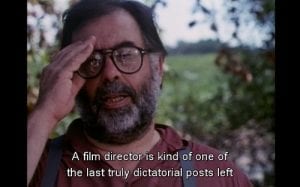You may have heard some of the crazy stories from Francis Ford Coppola’s frenzied production of Apocalypse Now. It’s lauded as one of the great films of the 1970s now, but during production many people didn’t even believe the film would ever see the light of day.
The production itself is infamously considered one of the toughest of all time, and some of the trials and tribulations are explained in this post.
On March 1, 1976, Coppola and his family flew to Manila and rented a large house there for the five-month shoot. Sound and photographic equipment had been coming in from California on a regular basis since late 1975.Principal photography began three weeks later.
Within a few days, Coppola was not happy with Harvey Keitel’s take on Willard, saying that the actor “found it difficult to play him a passive onlooker”. After viewing early footage, the director took a plane back to Los Angeles and replaced Keitel with Martin Sheen.
Typhoon Olga wrecked the sets at Iba and on May 26, 1976, production was closed down. Dean Tavoularis remembers that it “started raining harder and harder until finally it was literally white outside, and all the trees were bent at forty-five degrees”.
One part of the crew was stranded in a hotel and the others were in small houses that were immobilized by the storm. The Playboy Playmate set had been destroyed, ruining a month’s shooting that had been scheduled. Most of the cast and crew went back to the United States for six to eight weeks.
Tavoularis and his team stayed on to scout new locations and rebuild the Playmate set in a different place.
Also, the production had bodyguards watching constantly at night and one day the entire payroll was stolen. According to Coppola’s wife, Eleanor, the film was six weeks behind schedule and $2 million over budget.
Coppola flew back to the U.S. in June 1976. He read a book about Genghis Khan to get a better handle on the character of Kurtz. After filming commenced, Marlon Brando arrived in Manila very overweight and began working with Coppola to rewrite the ending.
The director downplayed Brando’s weight by dressing him in black, photographing only his face, and having another, taller actor double for him in an attempt to portray Kurtz as an almost mythical character.
In the days after Christmas 1976, Coppola viewed a rough assembly of the footage he had to date but still needed to improvise an ending. He returned to the Philippines in early 1977 and resumed filming.
On March 5, 1977, Sheen had a heart attack and struggled for a quarter of a mile to reach help. He was back on the set on April 19.
A major sequence in a French plantation cost hundreds of thousands of dollars but was cut from the final film.
Rumors began to circulate that Apocalypse Now had several endings but Richard Beggs, who worked on the sound elements, said, “There were never five endings, but just the one, even if there were differently edited versions”. These rumors came from Coppola departing frequently from the original screenplay.
Coppola admitted that he had no ending because Brando was too fat to play the scenes as written in the original script. With the help of Dennis Jakob, Coppola decided that the ending could be “the classic myth of the murderer who gets up the river, kills the king, and then himself becomes the king — it’s the Fisher King, from The Golden Bough“.
A water buffalo was slaughtered with a machete for the climactic scene. The scene was inspired by a ritual performed by a local Ifugao tribe which Coppola had witnessed along with his wife (who filmed the ritual later shown in the documentary Hearts of Darkness) and film crew.
Although this was an American production subject to American animal cruelty laws, scenes like this filmed in the Philippines were not policed or monitored, and the American Humane Association gave the film an “unacceptable” rating.
Principal photography ended on May 21, 1977 and everyone headed home.
Ready to learn about more Film History & Film Movements?
Matt Crawford
Related posts
2 Comments
Leave a Reply Cancel reply
This site uses Akismet to reduce spam. Learn how your comment data is processed.




One of my favorites, thanks!
Thanks for the support, Debra1654.